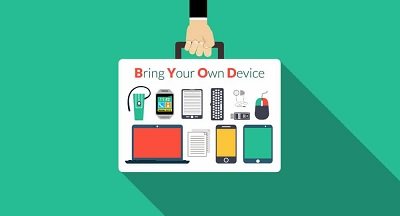The concept of Bring Your Own Device (BYOD) has revolutionized how we work. It allows employees to use their personal devices, such as smartphones, tablets, and laptops, for work-related tasks. While BYOD offers numerous benefits, including increased productivity and flexibility, it also brings inherent risks that organizations must address. Managed IT Services Atlanta experts assist you in reducing the risks of BYOD. In this blog post, we’ll explore the main risks associated with BYOD and provide actionable strategies to avoid them, ensuring a secure and productive work environment for your organization.
Security Risks
Security is one of the most significant concerns when it comes to BYOD. Employees using their devices may inadvertently expose sensitive company data to various threats.
Data Breaches
Data breaches can have catastrophic consequences for businesses. When employees access company resources from their personal devices, there’s a risk that sensitive data may be exposed or stolen. Consider implementing encryption, access controls, and data loss prevention (DLP) solutions to mitigate this risk. Additionally, monitoring and auditing data access can help identify and address potential breaches before they escalate.
Malware and Viruses
Personal devices are often less secure than corporate-managed devices. Employees may unwittingly download malicious software or visit compromised websites, putting company data at risk. To combat this, enforce strict security policies, require antivirus software installation, and promote safe browsing practices.
Unauthorized Access
Without proper controls, employees may share their devices with family members or friends, inadvertently allowing unauthorized access to company data. Implementing multi-factor and strong password policies can help prevent unauthorized access to sensitive information.
Lost or Stolen Devices
The loss or theft of personal devices can be a significant security risk. Ensure that employees promptly report lost or stolen devices and have remote wiping capabilities in place to erase sensitive data remotely. Encourage employees to use device locking mechanisms and biometric authentication to protect their devices.
Compliance and Legal Risks
Meeting regulatory requirements and protecting intellectual property are essential to BYOD risk management.
Data Privacy Regulations
Data privacy laws like GDPR and CCPA require organizations to protect personal data. When employees use their personal devices, it can be challenging to ensure compliance. To address this risk, create a BYOD policy that includes data handling guidelines, consent forms, and procedures for data erasure upon request.
Intellectual Property Concerns
Employees may transfer company files to their personal devices, potentially putting intellectual property at risk. To mitigate this, establish clear policies regarding data ownership and separate personal and work-related data. Use encryption and access controls to safeguard intellectual property.
E-Discovery Challenges
In the event of legal proceedings, retrieving electronic documents for e-discovery can be complicated when employees use their devices for work. Implementing effective e-discovery solutions and maintaining records of employee device usage can help streamline this process.
Management and Support Risks
Managing a diverse range of personal devices can be challenging for IT departments. Engage IT Consulting New Jersey professionals to overcome such challenges.
Compatibility Issues
The variety of device types and operating systems used in BYOD environments can lead to compatibility issues. To address this, prioritize widely supported platforms and establish device standards to minimize compatibility problems.
Technical Support
Providing technical support for employees’ personal devices can strain IT resources. Consider offering limited support, such as guidance for device configuration, while clearly defining the scope of IT assistance. Alternatively, explore the option of outsourcing technical support for BYOD users.
Employee Training
Inadequate employee training can result in security breaches and inefficiencies. Invest in comprehensive training programs that educate employees on BYOD policies, security best practices, and the responsible use of personal devices for work.
Strategies to Mitigate BYOD Risks
Now that we’ve explored the main risks associated with BYOD, let’s discuss practical strategies to mitigate these risks and promote a secure and productive BYOD environment.
Implement a Strong Mobile Device Management (MDM) Policy
A robust MDM policy is the cornerstone of BYOD security. It allows organizations to enforce security settings, remotely manage devices, and monitor compliance. Key elements of an MDM policy include:
- Device enrollment: Require devices to be registered and authorized before accessing company resources.
- Remote wiping: Enable the ability to erase data from lost or stolen devices remotely.
- App whitelisting: Allow only approved applications to run on company-managed devices.
- Regular updates: Ensure devices are updated with the latest security patches.
Establish Clear BYOD Guidelines
Clearly communicate BYOD policies and guidelines to all employees. This includes acceptable use policies, data handling procedures, and security best practices. Encourage employees to review and acknowledge these policies regularly.
Regularly Update and Patch Devices
Ensure employees’ devices are updated with the latest operating system and software updates. Outdated devices are more vulnerable to security threats. Consider automating update notifications to encourage prompt installation.
Conduct Security Audits and Assessments
Regularly assess the security of BYOD devices and the data they access. Conduct security audits to identify vulnerabilities and areas for improvement. This proactive approach helps address potential issues before they lead to security breaches.
Provide Ongoing Employee Education
Invest in continuous employee education and training programs focused on BYOD security. Regularly update employees on emerging threats, best practices, and policy changes. Encourage a culture of responsibility and vigilance when it comes to device security.
Encourage Safe User Behavior
Promote safe user behavior among employees. Emphasize the importance of strong passwords, secure Wi-Fi connections, and the dangers of downloading apps or clicking on links from untrusted sources. Encourage reporting of security incidents and suspicious activities.
Conclusion
BYOD offers undeniable advantages regarding flexibility and productivity but introduces various security, legal, and management challenges. To successfully navigate these risks, organizations must implement a comprehensive BYOD strategy prioritizing security, compliance, and user support. Following the strategies outlined in this blog post, you can create a secure BYOD environment that empowers employees to use their personal devices while safeguarding company data and intellectual property. Remember that the key to a successful BYOD program lies in proactive planning, strong policies, and ongoing education and support.

